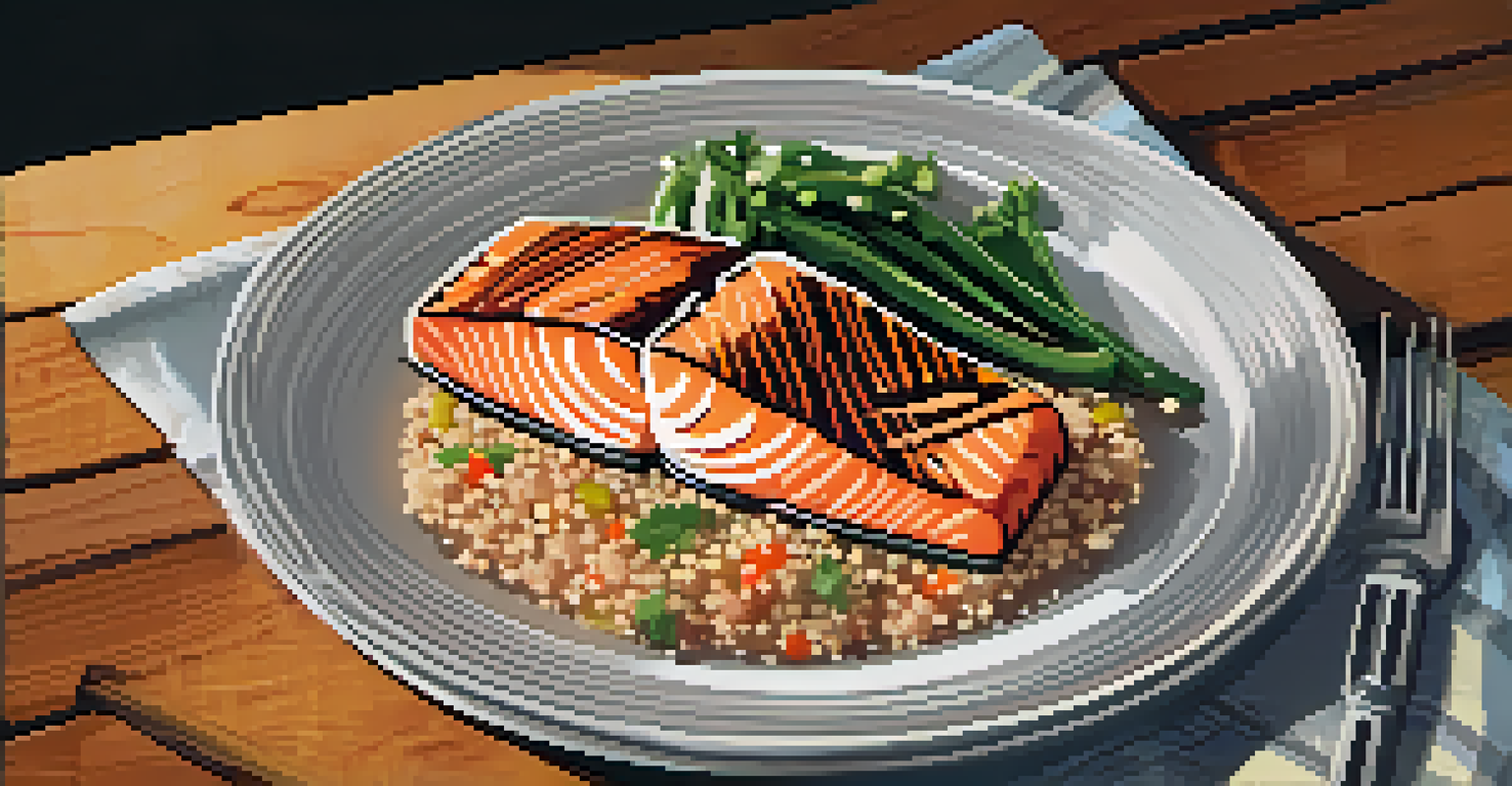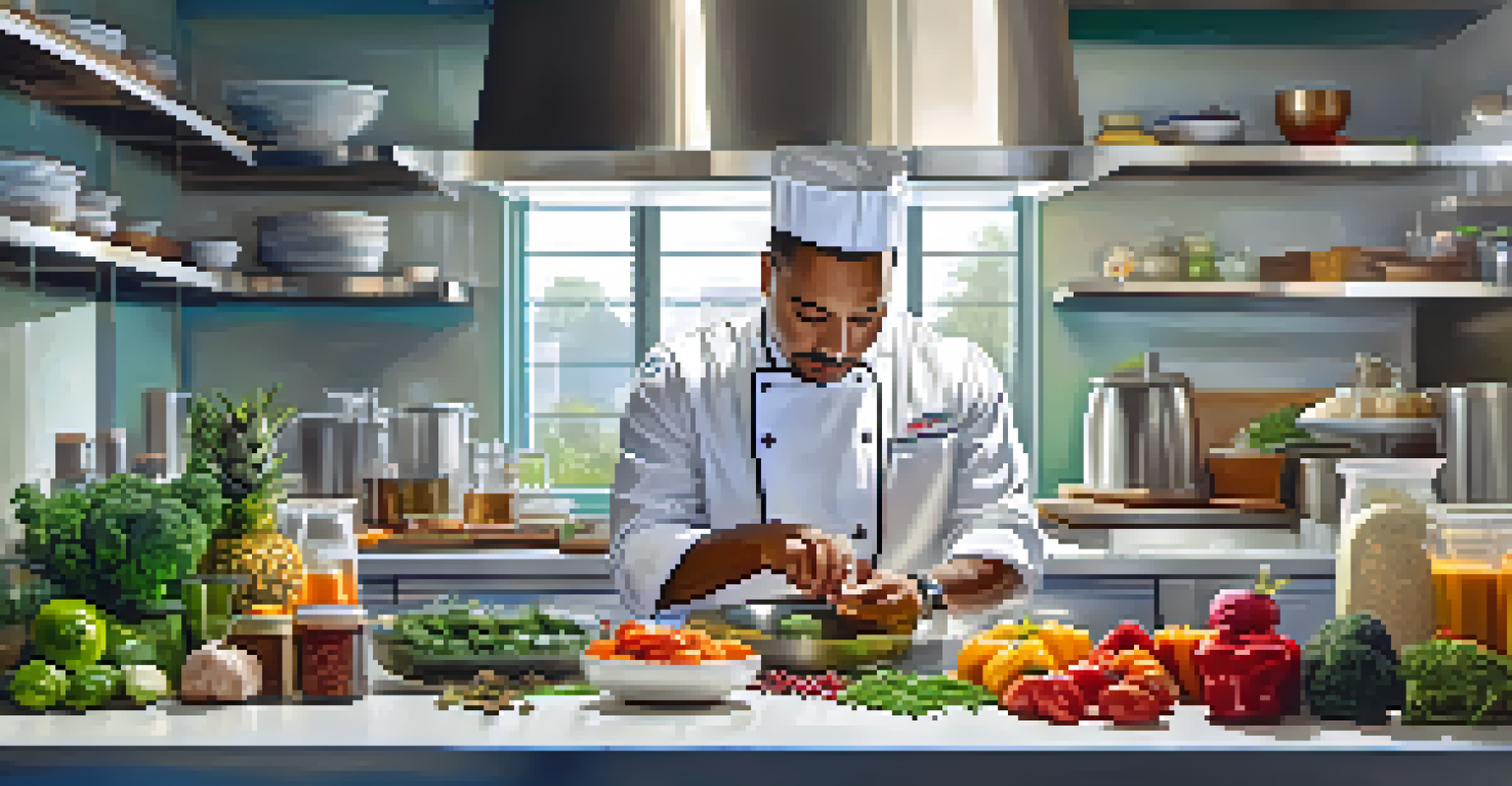Culinary Arts and Chemistry: The Science of Cooking

The Intersection of Culinary Arts and Chemistry
Culinary arts and chemistry may seem like two separate worlds, but they are closely intertwined. Every time you cook, you are engaging in a chemical process, whether you're caramelizing sugar or emulsifying oil and vinegar. Understanding these chemical reactions can elevate your cooking from basic to extraordinary, revealing the science behind your favorite dishes.
Cooking is like love. It should be entered into with abandon or not at all.
For instance, the Maillard reaction, which occurs when proteins and sugars are heated, is responsible for the delightful browning of meats and baked goods. This transformation not only enhances flavor but also adds complexity to the dish. By grasping these concepts, home cooks can become more intentional in their culinary creations.
Additionally, the art of seasoning relies on chemistry as well. Salt, for example, enhances flavors through a process called osmosis, drawing out moisture and intensifying taste. When you understand how these elements work together, you can create dishes that are perfectly balanced and delicious.
Understanding the Role of Temperature in Cooking
Temperature is a crucial factor in the science of cooking, influencing everything from texture to flavor. Different methods of cooking, such as boiling, baking, or frying, rely on varying temperatures to achieve desired outcomes. For example, low and slow cooking allows tougher cuts of meat to break down, becoming tender and flavorful over time.

Conversely, high-heat methods like searing create a crispy exterior while keeping the inside juicy. This contrast is achieved through the rapid cooking of proteins, which forms a crust that locks in moisture. By mastering temperature control, cooks can turn ordinary ingredients into culinary masterpieces.
Culinary Arts Meet Chemistry
Understanding chemical processes, like the Maillard reaction and emulsification, can elevate your cooking and enhance flavors.
Furthermore, understanding the science of temperature can help prevent common cooking mishaps, such as overcooking or undercooking. Using a thermometer to monitor internal temperatures can ensure that meats are safely cooked while still retaining their desired juiciness.
The Importance of pH in Cooking
pH plays a vital role in cooking, influencing flavor, texture, and even color. Foods with a low pH, like citrus fruits, can brighten dishes and enhance flavors, while high pH ingredients, such as baking soda, can alter textures and promote browning. Understanding how to manipulate pH can open up a world of culinary possibilities.
The only real stumbling block is fear of failure. In cooking, you’ve got to have a what-the-hell attitude.
For instance, when making pickles, the acidity of vinegar (low pH) is essential for preserving vegetables and enhancing their crunch. Similarly, when baking, the pH balance between baking soda and acidic ingredients like buttermilk creates the perfect rise in baked goods, resulting in light and fluffy cakes and breads.
Additionally, the pH level can affect the color of certain foods, such as red cabbage, which changes from red to blue depending on the acidity of the cooking environment. This knowledge not only helps in achieving aesthetic appeal but also in creating well-rounded flavors.
Emulsification: The Science Behind Sauces and Dressings
Emulsification is a fascinating process that combines two liquids that typically don't mix, such as oil and vinegar. This is a fundamental technique in creating dressings, sauces, and mayonnaise. Understanding the science behind emulsification can help home cooks create smooth and stable mixtures, enhancing the overall dining experience.
The key to a successful emulsion lies in the use of an emulsifier, which is a substance that stabilizes the mixture. Common emulsifiers include egg yolks and mustard, which contain proteins that help bind the oil and vinegar together. By whisking these ingredients vigorously, you create a temporary bond that results in a creamy texture.
Temperature's Impact on Cooking
Mastering temperature control in cooking can transform ordinary ingredients into culinary masterpieces by influencing texture and flavor.
However, the bond can break if too much oil is added too quickly or if the mixture is left undisturbed. Learning how to properly emulsify not only improves the texture of sauces but also allows for creative flavor combinations that can elevate any dish.
Fermentation: A Culinary Science Marvel
Fermentation is a culinary process steeped in history and science, transforming simple ingredients into complex flavors. This process relies on microorganisms like bacteria and yeast to convert sugars into acids, gases, or alcohol. Fermented foods, such as yogurt, kimchi, and sourdough bread, are not only delicious but also packed with health benefits.
For example, in sourdough bread, wild yeast and bacteria work together to create a tangy flavor and chewy texture. The fermentation process also enhances the bread's digestibility, making it easier on the stomach. By embracing fermentation, cooks can explore a whole new realm of flavor while also preserving food.
Moreover, understanding fermentation allows cooks to experiment with various ingredients and techniques, creating unique dishes that reflect their personal style. This age-old method is a perfect example of how science can enhance culinary creativity.
Science of Baking: Precision and Chemistry
Baking is often regarded as a science, requiring precision and an understanding of chemical reactions. Unlike cooking, which allows for improvisation, baking demands accurate measurements and timing to achieve the desired results. Ingredients like flour, sugar, and leavening agents work together in specific ways to produce the perfect loaf of bread or cake.
For example, the role of baking powder and baking soda in recipes is crucial, as they create carbon dioxide gas that causes dough to rise. If too much or too little is used, the texture and flavor can be significantly affected. This highlights the importance of understanding the chemistry behind baking ingredients.
Exploring Flavor Pairing Chemistry
By grasping the chemistry behind flavor pairing, cooks can create harmonious and innovative dishes that delight the palate.
Furthermore, temperature and humidity can also impact baking outcomes. Keeping an eye on these factors ensures that baked goods turn out consistently delicious, showcasing the intricate relationship between science and culinary arts.
Flavor Pairing: The Chemistry of Taste
Flavor pairing is an exciting concept rooted in the chemistry of taste, allowing chefs to create harmonious dishes that delight the palate. Certain flavor compounds naturally complement each other, resulting in combinations that enhance the overall dining experience. By understanding these relationships, cooks can innovate and elevate their culinary creations.
For instance, the pairing of chocolate and coffee works so well because both contain similar flavor compounds, which intensify each other's richness. Similarly, complementary herbs and spices can transform a dish by adding depth and complexity. This science behind flavor pairing encourages creativity in the kitchen.

Moreover, flavor pairing can also be guided by understanding regional cuisines, where certain ingredients historically come together due to availability and cultural preferences. Embracing this chemistry not only enhances dishes but also invites exploration and experimentation in cooking.
The Future of Culinary Arts and Food Science
As technology advances, the intersection of culinary arts and food science continues to evolve, offering exciting new possibilities for chefs and home cooks alike. Innovations like molecular gastronomy have opened doors to creative and unexpected culinary experiences, allowing chefs to manipulate textures, flavors, and presentations in ways previously unimaginable.
Moreover, the rise of food science education and resources has empowered a new generation of cooks to explore the chemistry behind their culinary creations. This deeper understanding enhances not only the quality of dishes but also fosters a greater appreciation for the artistry of cooking.
Looking ahead, the fusion of culinary arts and science will likely lead to even more groundbreaking techniques and flavors, transforming how we think about food. By embracing this relationship, we can all become better cooks and food enthusiasts, truly appreciating the magic that happens in the kitchen.